Navigating the Transition: RYA #DigitalFirst and the Future of Paper Charts
An Introduction and Background
Paper charts have guided sailors for centuries, evolving with time to provide detailed navigational guidance. The UK Hydrographic Office (UKHO) recently caused waves by announcing the phasing out of Admiralty paper charts. Initially planned for 2026, strong feedback led to an extension to at least 2030. Crucially, the UKHO and industry leaders assure sailors that paper charts will remain available and updated until digital alternatives fully meet mariners’ needs.
Globally, similar shifts are occurring. NOAA, the U.S. chart authority, ceased creating raster charts in 2025, opting instead for print-on-demand vector charts. The International Maritime Organization (IMO) established a special working group to develop new standards for leisure electronic charts, tied to the emerging “S-Mode” initiative, which aims for consistent chart interfaces across brands.
Imray, a respected nautical publisher, has formed a partnership with Freytag & Berndt to ensure its paper charts remain available beyond 2025, reinforcing the industry’s commitment to supporting sailors during this transition.
Understanding #DigitalFirst and RYA Training
RYA’s #DigitalFirst approach isn’t abandoning traditional methods; it integrates electronic navigation skills alongside paper-based techniques. Practical course standards now explicitly require students to use chartplotters as well as paper charts. The goal is simple: skippers should confidently use and cross-check electronic and traditional tools.
Essential Updates to Day Skipper Syllabus:
- “Course to Steer” is shifting towards “Shaping a Course,” emphasising a comprehensive understanding of wind and tide effects, moving beyond manual calculations.
- “Position Fixing” now emphasises multiple “Lines of Position,” using various visual and electronic sources for continuous position monitoring rather than solely relying on three-point fixes.
- Tidal data teaching expands to include digital apps and online resources, complementing traditional tables and atlases.
- A strong emphasis on teaching sailors to safely and critically evaluate electronic navigational tools, ensuring accuracy and reliability.
These updates modernise training, reflecting real-world practices without diminishing foundational knowledge. Current Day Skipper exams remain unchanged, but instructors should familiarize themselves with new terminology and concepts.
All Skills Remain Relevant
Those trained traditionally under current syllabi remain well-prepared—often even “overprepared.” Traditional navigation skills offer foundational understanding, easing the transition to new digital methods.
Embracing All Navigation Tools
The essence of #DigitalFirst is balance. Paper charts continue as legal standards and primary planning resources. Electronic navigation enhances, rather than replaces, traditional methods. Instructors should encourage navigators to confidently integrate paper and digital techniques, continually cross-checking for safety and accuracy.
At the end of the day, good navigation is still good navigation. And a chart is still a chart, paper or electronic. These adjustments to training are all about ensuring these messages remain consistent as the tools we use develop.
S-Mode, and new Standards, Coming Soon
The IMO’s rumoured “S-Mode” standards aim to standardize electronic chart displays, simplifying training and ensuring consistency across platforms. Learn on one, be able to use all. While fully realized S-Mode standards are not yet available, sailors should embrace adaptable navigation practices to prepare for these advances.
But S-Mode isn’t all that is required to legally use electronic charts as a replacement to paper charts. The electronic chart displays will also need new functionality so that we can use them to complete manual fixes, graphical calculations, and anything else we traditionally use a paper chart for. They need to work without GNSS input too. This is outlined in the new standards proposed by the MCA titled SV-ECS.
SV-ECS is specifically for vessels under 24 metres. SV-ECS defines clear requirements for electronic charts and equipment, mandating official Electronic Navigational Charts (ENCs), specified screen sizes, and reliable backup systems. It’s a vital step to enable smaller commercial vessels to legally replace paper charts with compliant electronic systems, ensuring safety, consistency, and accuracy as digital navigation evolves.
Questions?
For any queries or clarification, please connect with us. Ardent Training regularly hosts webinars and engages with industry leaders to keep you confidently ahead in this evolving navigational landscape.

